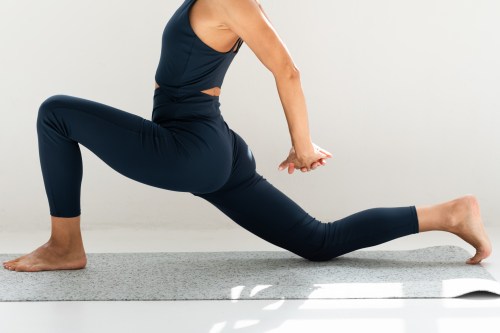Butterfly pose (known as Baddha Konasana in Sanskrit) is a beginner-friendly yoga pose that helps open up your hips and ease tension.
Experts in This Article
lead yoga teacher at YogaSix
It also helps stretch and strengthen many different muscles in your upper legs. This makes it a wonderful stretch for people with tight hip flexors, such as runners or folks who have a desk job, according to Emily Forte, E-RYT 500, YACEP, lead yoga teacher at YogaSix in Glen Mills, Pennsylvania.
To get the most out of this seated yoga posture, we spoke to Forte on how to do butterfly pose in yoga properly and all the different variations you can try to deepen the stretch.
How to do butterfly pose in yoga the right way every time
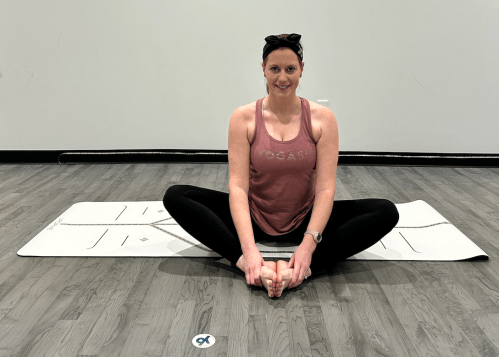
- 1.Start by sitting on a yoga mat with your legs extended out in front of you.
- 2.Bend your knees to bring the soles of your feet together evenly from toes to heels.
- 3.Grasp your feet with your hands.
- 4.Sit up tall with a straight spine, engaging your core muscles to support your back.
- 5.You can try gently pressing your knees down toward the floor with your hands if it’s comfortable for you. Keep the soles of your feet together throughout the pose.
- 6.Stay in the pose for at least 30 seconds.
- 7.To come out of the pose, slowly bring your knees together and extend your legs out in front of you.
Butterfly pose muscles worked
Butterfly pose in yoga mostly targets the muscles in your thighs and core. Here’s a breakdown of all the muscles butterfly pose works.
- Adductors: These are your inner thigh muscles, and they extend down from the pelvic bone down to the inner thigh and knee. As you bring your knees out to the sides, you’ll feel your adductors getting a good stretch. Folding forward in the pose (a variation you’ll see below) can help you deepen the inner-thigh stretch even more.
- Quadriceps: Also known as quads, or your front thigh muscles, the butterfly gives you a nice quad stretch while opening your hip flexors.
- Lower back muscles: Butterfly pose can help soothe tension in your lower back muscles along your spine.
- Abdominals: Sitting up straight in the pose can help work your ab muscles in your core, improving your posture.
Butterfly pose benefits
1. It loosens tight hips and back
Butterfly pose strengthens your inner thigh muscles, lower back, and the front of your thighs. That’s what makes it an “important stretch for anyone who sits at a desk most of the day, which can cause hip flexors to be weak, or runners and athletes that may have tight hip flexors,” Forte says.
Tight hips and back can contribute to poor posture and discomfort, which you might feel if you have a desk job, and can even mess with your body’s alignment. Regularly doing butterfly pose can help loosen those tight hip flexors and improve your flexibility and range of motion.
2. It’s safe during pregnancy
Butterfly pose is safe and helpful to do during pregnancy because it can help release tension in your low back, hips, and inner thighs, according to Forte.
“Butterfly pose can also build strength in the pelvic floor muscles and help with circulation in the pelvic floor region. Having a strong pelvic floor can also decrease the strain the muscles experience during pregnancy and can later assist with labor and delivery,” Forte says.
If the pose is difficult or uncomfortable during pregnancy, try positioning your feet farther away from the groin area.
3. It can help improve your posture
Butterfly pose requires you to sit in an upright position, which engages your core and lower back. These two muscle groups are essential for good posture, so adding butterfly pose to your routine more often might just help you stand up taller.
4. It might help strip away stress
Yoga is known to help calm the mind, and adding the butterfly pose to your practice might help you let go of stress in your inner thighs and hips. A July 2020 review in Alternative Therapies In Health and Medicine concluded that many yoga practices are beneficial for reducing stress.
Butterfly pose variations
Different variations of a pose can help you address specific areas of tightness or weakness. Here, Forte shares her go-to butterfly pose variations to try if seated butterfly isn’t challenging enough.
1. Butterfly pose with forward bend
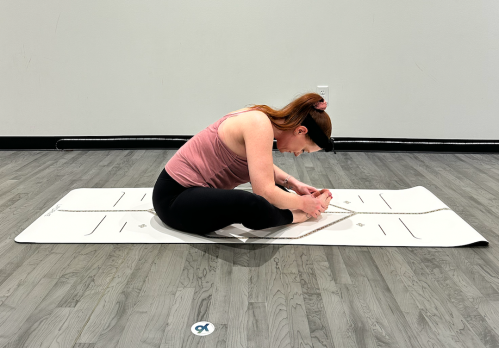
- 1.Start by sitting on a yoga mat with your legs extended out in front of you.
- 2.Bend your knees to bring the soles of your feet together evenly from toes to heels.
- 3.Grasp your feet with your hands.
- 4.Sit up tall with a straight spine, engaging your core muscles to support your back.
- 5.Slowly begin to hinge your torso forward, allowing your spine to round as soon as you feel a sensation or tightness in your low back.
- 6.Draw your gaze down at your ankles or into your thighs or belly button and lower the top of your head toward your feet.
- 7.To come out of the pose, slowly lift your torso back up, bring your knees together, and extend your legs out in front of you.
2. Supine butterfly pose with bolster
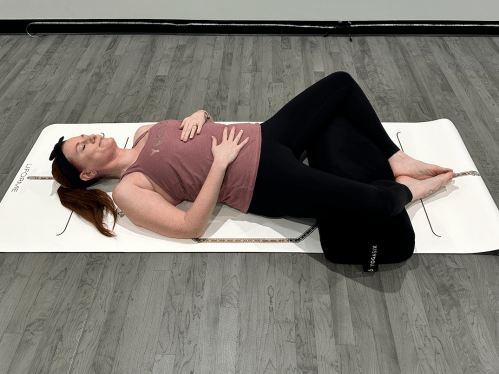
- 1.Start from a seated position with your knees together.
- 2.Guide your feet away from your body, then slide a bolster vertically underneath your knees and between your sit bones and heels.
- 3.Slowly roll back onto your hands, the back of your arms, and to your back.
- 4.Once you’re on your back, open your knees out to the sides, and feel the bolster supporting your knees and outer thighs.
3. Butterfly pose with strap

- 1.Start by sitting on a yoga mat with your legs extended out in front of you.
- 2.Bend your knees to bring the soles of your feet together evenly from toes to heels.
- 3.Create one long loop with your strap or yoga belt and place it behind your back on top of your hip bones.
- 4.Slide your feet 4 to 5 inches away from your body and place the other end of the loop around the top of your feet.
- 5.Tighten your strap or loop until you feel light pressure on your hips and feet.
- 6.Sit up tall with a straight spine, engaging your core muscles to support your back.
- 7.To come out of the pose, slowly bring your knees together and extend your legs out in front of you.
4. Supine butterfly pose with strap
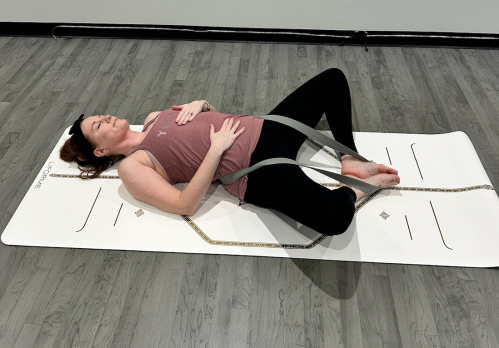
- 1.Start from a seated position with your knees together.
- 2.Keep some length on the loop of your strap. Wrap it around your hips and your feet.
- 3.Slowly roll back onto your hands, the back of your arms, and to your back.
- 4.If you don’t have enough tension or don’t feel a “hugging” sensation on your low back and feet, sit back up and tighten your strap. In contrast, if you feel as if the strap is pulling your knees up, or you can’t roll to your back while keeping it in place, decrease the tension on your strap, and add length until your feel comfortable.
- 5.Once you’re on your back, open your knees out to the sides, and feel the bolster supporting your knees and outer thighs.
5. Butterfly pose with legs up against wall

- 1.Place your yoga mat perpendicular to a wall and place a cushion right up against the wall.
- 2.Sit with your left side against the wall.
- 3.Gently turn your body to the left and carefully swing your legs up the wall.
- 4.Lower your back to the floor and lie down, placing your hands on your stomach.
- 5.Slide the soles of your feet together and allow your knees to widen.
Tip: Add a bolster under your low back for support and comfort if needed.
Common mistakes made in butterfly pose
Pain isn’t a sign you’re doing a pose right. If you start to feel a sensation in the lower back while you’re in butterfly pose, Forte recommends rounding your spine and rolling your head toward your feet. This can help relieve some of the tension in your lower back.
Another common mistake Forte sees: “Students often pull their legs in too close to their groin, which can also lead to low back pain, or knee pain.”
To fix this, bring your feet farther away from your body to release discomfort and promote a deeper stretch in your hips, she says.
Tips to prevent injury
As beginner-friendly as butterfly pose is, you’ll still want to listen to your body and pay attention to any pain points. If you have knee or groin injuries, consider avoiding doing butterfly pose altogether or trying modifications.
If you have knee pain, using rolled-up blankets or yoga blocks underneath each knee can help pad the area, Forte says.
Doing butterfly pose with a forward fold might bother people with sciatica or lower back issues, and the supine version may be a better option for those with sciatica pain. If you have sciatica or lower back pain, stay seated upright with a long spine and a lifted torso, Forte says. “It can also help to stay seated against a wall, or slide a block under the feet for spinal support.”
FAQ
1. How do you incorporate butterfly pose into your yoga practice?
Try adding butterfly pose to the cooldown portion of a mindful yoga practice, as your hips may already be stretched from practicing other poses, like lunges or warriors.
“You can also add the supine versions or legs-up-the-wall version as a variation of Savasana, or the final resting pose,” Forte says. “Butterfly pose is also a great pose to incorporate into a yin or restorative practice to target the hips, especially the supine version with a bolster or a strap.”
2. How many minutes should I do butterfly pose?
You can stay in seated butterfly for 5 to10 minutes, Forte recommends. If you’re trying the supine or legs-up-the-wall variations of butterfly, try staying in the pose for 10 to 20 minutes “to release muscle tension and to activate the parasympathetic nervous system—our ‘rest and digest’ or relaxation response,” Forte says.
“Long holds of butterfly pose can also promote myofascial release in our connective tissues and stimulate anti-inflammatory effects,” she says.
As with any pose, come out or draw your knees back together if you feel discomfort. (Wondering how often you should do yoga in general? We got you covered.)
3. Who should not do butterfly pose?
People with knee or groin injuries might be best off avoiding butterfly pose. If you feel pain or discomfort in a pose, slowly ease out of it and consider a modification or skipping the pose altogether.
It’s a smart idea to check with a physical therapist before adding new movements to your routine if you have any pain or injuries.
Sign Up for Our Daily Newsletter
Get all the latest in wellness, trends, food, fitness, beauty, and more delivered right to your inbox.
Got it, you've been added to our email list.






